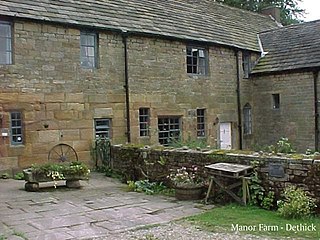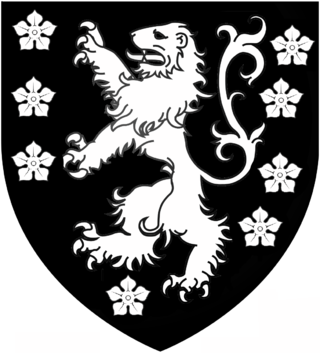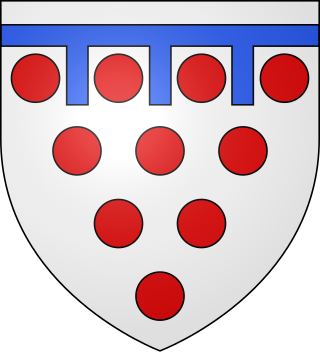Year 1485 (MCDLXXXV) was a common year starting on Saturday of the Julian calendar.
Sir James Tyrrell was an English knight, a trusted servant of king Richard III of England. He is known for confessing to the murders of the Princes in the Tower under Richard's orders. William Shakespeare portrays Tyrrell as the man who organises the princes' murder in his 1593 play Richard III.

John Howard, 1st Duke of Norfolk, also known as Jack of Norfolk,, was an English nobleman, soldier, politician, and the first Howard Duke of Norfolk. He was a close friend and loyal supporter of King Richard III, with whom he was slain at the Battle of Bosworth in 1485.
Sir Robert Brackenbury was an English courtier, who was Constable of the Tower of London during the reign of Richard III. He is believed to have been responsible for enabling the (presumed) murders of the Princes in the Tower, though there is no conclusive evidence to prove it. He died defending the King at the Battle of Bosworth Field in 1485.

Sir William Brandon of Soham, Cambridgeshire was Henry Tudor's standard-bearer at the Battle of Bosworth, where he was killed by King Richard III. He was the father of Charles Brandon, 1st Duke of Suffolk.

Walter Devereux, 8th Baron Ferrers of Chartley, KG was an English nobleman and a loyal supporter of the House of York during the Wars of the Roses. He was a member of the inner circle of King Edward IV, and died fighting for Edward's younger brother, King Richard III, at the Battle of Bosworth in 1485.
William II de Ferrers, 4th Earl of Derby, was a favourite of King John of England. He succeeded to the estate upon the death of his father, William de Ferrers, 3rd Earl of Derby, at the Siege of Acre in 1190. He was head of a family which controlled a large part of Derbyshire which included an area known as Duffield Frith.
The Standard Bearer of England was once an important office within the English army, especially during the times when Kings were still present on the battlefield. As standard-bearer Henry de Essex was greatly chastised when he threw down the English Standard and claimed his King (Stephen) was dead in 1153.
The Sheriff of Nottinghamshire, Derbyshire and the Royal Forests is a position established by the Normans in England.

The Manor of Clifton was a historic manor situated near the City of Nottingham, England. The manor house, known as Clifton Hall is situated on the right bank of the River Trent in the village of Clifton, Nottinghamshire,. about 3+1⁄2 miles south-west of the historic centre of the City of Nottingham, now partly the campus of Nottingham Trent University and partly a large council estate of modern housing.

Dethick Manor is a 16th-century manor house, situated at Dethick, Amber Valley, Derbyshire, much altered in the 18th century and converted to use as a farmhouse. It is a Grade II* listed building.

Two unrelated baronetcies have been created in the surname of Clifton.
The Vernon family was a wealthy, prolific and widespread English family with 11th-century origins in Vernon, Normandy, France. Their extant titles include Baron Vernon and Vernon baronets of Shotwick Park.
Sir Anthony Babington, was an English politician.
Sir Richard Hastings, Baron Welles, was the son of Sir Leonard Hastings and a younger brother of William Hastings, 1st Baron Hastings. He was a favourite of Edward IV, who granted him the lands of the baronies of Willoughby and Welles after he had married the heiress, Joan Welles. He fought at Tewkesbury. He died in 1503, and was buried at the Greyfriars, London.
Sir Edward Aston of Tixall, Staffordshire was Sheriff of Staffordshire.
Kevin SchürerFAcSS FRGS is a British historian, genealogist and statistician, previously Pro-Vice Chancellor of Research and Enterprise, who teaches at the University of Leicester. He specialises in the historical demography, the history of the family and migration in nineteenth-century England and Wales.

Sir John Savage, KG, KB, PC (1444–1492), was an English knight of the Savage family, who was a noted military commander of the late 15th-century. Savage most notably fought at the Battle of Bosworth Field in 1485, where he commanded the left flank of the Tudor (Lancastrian) army to victory and is said to have personally slain the Duke of Norfolk in single combat. Earlier in the Wars of the Roses, Savage had been a supporter and friend of the Yorkist King Edward IV, fighting alongside him and helping him to victories at the Battle of Barnet in 1471 and the Battle of Tewkesbury later that same year, as well as joining the Duke of Gloucester's invasion of Scotland in 1482, where the Duke made him a Knight banneret. However, following the death of Edward and the Duke of Gloucester's ascension to the throne as Richard III the Savage family was viewed with suspicion due to their familial connection to the Stanleys, who were in turn connected to the Tudors. Consequently Savage was one of the prominent figures who invited Henry Tudor to invade England in 1485, a struggle which culminated in the Battle of Bosworth Field. After his victory Henry Tudor received the circlet of Richard from Savage's uncle Lord Stanley and was crowned King of England on the field of battle, taking the throne as Henry VII of England.

Babington is the name of an Anglo-Irish and English gentry family. The Anglo-Irish branch of the family is still extant today.

Sir Henry Willoughby was a Knight of the Body to Kings Henry VII and Henry VIII and MGO.











